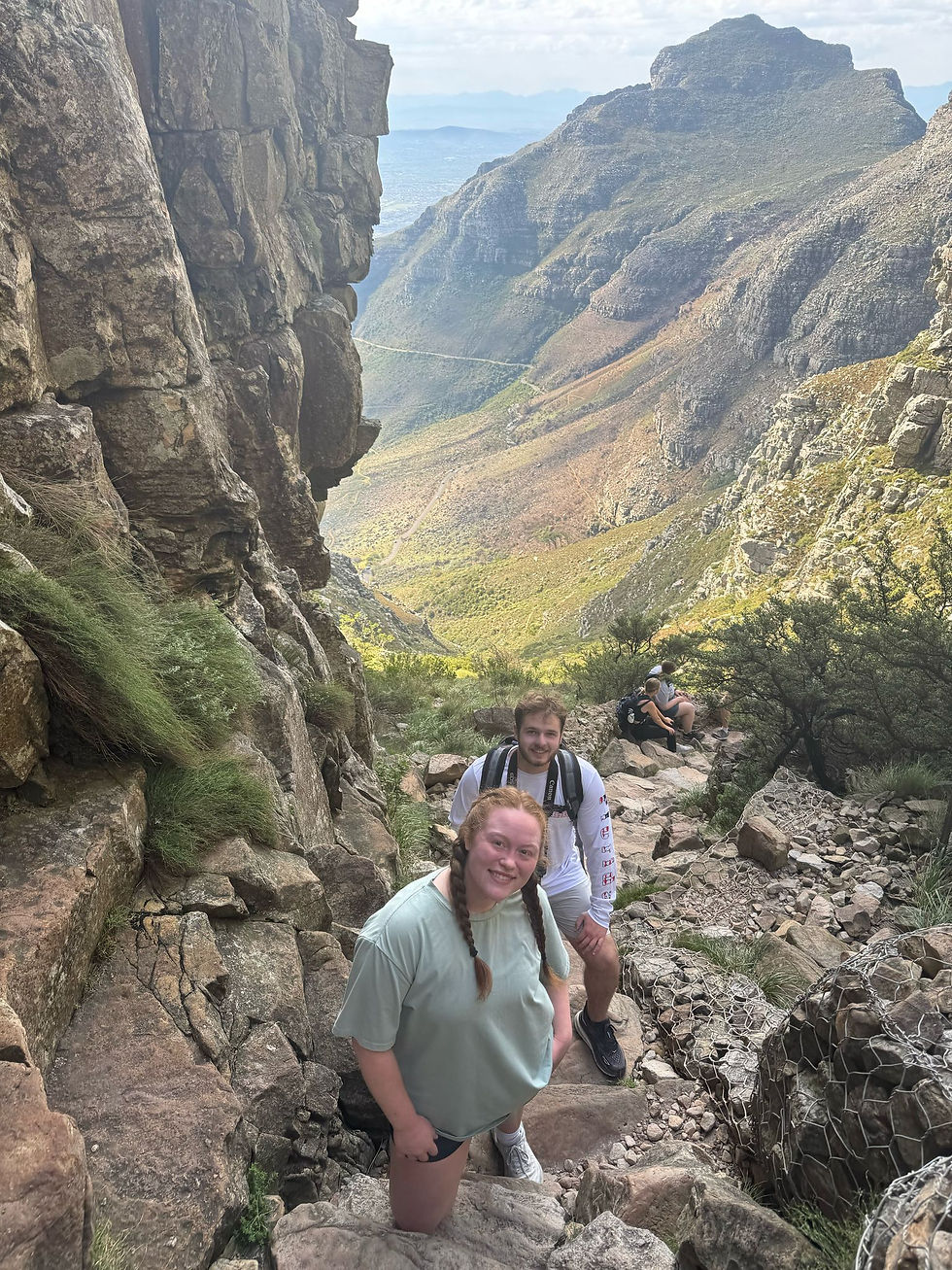An “Easy to Moderate” Hike up Table Mountain
- mtbersagelbraley
- May 18, 2025
- 5 min read
Sabrina (Biology ‘25) and Anthony (Biology ‘25)
This morning started like many others in Cape Town at (a now very familiar) Truth Coffee Roasting. A light breakfast, delicious coffee, and then an Uber to something unfamiliar: the start of our hike up Table Mountain.
We chose the Platteklip Gorge trail, one of the most direct (and steepest) routes to the summit. The path is carved into the mountain’s face with relentless switchbacks and jagged rocks. Now this was no “easy to moderate” hike. It was very difficult, but doable. The hike was as if we were on a stair master for over 3 hours. We took frequent pauses to catch our breath and take in the ever-expanding view of the city and sea below.
As we climbed (and what a challenge that was), we couldn’t help but think about the meaning of this mountain. Not just as a natural wonder, but as a witness to South Africa’s long journey through colonization, apartheid, resistance, and reconciliation. Table Mountain towers above Cape Town, a silent observer of the city’s complex history. It saw the first Dutch settlers arrive, the forced removals of District Six, and the boats ferrying prisoners to Robben Island.
It also holds spiritual significance for the Khoisan, South Africa’s first peoples, who lived in the shadow of this mountain long before colonial maps were drawn. Hiking it today felt like a quiet act of respect, to walk this land thoughtfully, to recognize its layers.

Reaching the top wasn’t easy by any means. After about 3 1/2 hours, with a total distance of 3.3 miles and elevation gain of 2,336 feet, we finally reached the top. A classmate’s Apple Watch said we climbed the equivalent of 172 flights of stairs. Our legs ached, our lungs burned, but the views were more than worth it. It reminded us of South Africa’s ongoing climb toward justice, unity, and healing. Just like the trail, it’s steep and uncertain in places, but filled with moments of perspective and beauty.
At the top, we grabbed a bite to eat, browsed the gift shop, and took pictures of the awe-inspiring view. Then, we boarded the gondola to get back down. It took all but 7 minutes to return to the base, but it was a calm moment for reflection. This experience wasn’t just a hike. It was a meditation on place, history, and the privilege of being able to learn and walk through it all.
After a 2-hour recovery period back at Scalabrini, we planned to meet in the kitchen for dinner at 5:30. However, at around 5:20, the fire alarm on our floor went off! Matthew quickly gathered all of us outside, where we waited for our host Fred to be our savior, who we now refer to as Firefighter Fred. Turns out a smoking hairdryer (from another guest - not us) was the cause for the alarm.
A brisk 15 minute walk took us to an Ethiopian restaurant called Madam Taitou. As we entered, we were immediately enthralled by the decorations coating each wall. There were tapestries, weapons, statues, tools, clothing, and more Ethiopian memorabilia. Our class was partitioned into two groups as we sat down at our round tables encircled by a gazebo-like structure. Rather than chairs, most of the seating options were couches, which complemented well with the dim lighting to provide a personal and cozy vibe.

Each group ordered platters that featured various types of meats and vegetables placed beautifully on a flat, sour pastry called injera. Rolls of injera were provided that surrounded the food that served as our utensils for the evening. For many of us, this was our first experience with Ethiopian cuisine, so the waiter kindly explained to us how to consume it. We were instructed to rip off sheets of injera from the roll and pick up the food with it, then deliver it to our mouths. With at least 7 people surrounding each platter, the food disappeared pretty quickly. We finished the night with gelato, revisiting our favorite parlor, Moro Gelato.
While visiting the Scalabrini Centre in Cape Town, we had the privilege of speaking with Firefighting (smoke fighting) Fred, whose journey from a Rwandan refugee to a dedicated community leader embodies both resilience and compassion. Fred arrived in South Africa at just 9 years old, growing up through its school system attending elementary school, high school, and later college all while navigating life as a refugee. His deep connection to the Scalabrini Centre began when he sought support there himself, living in one of their children's homes from age 9 to 18. Over time, he went from being a beneficiary to a volunteer, and today he serves on staff, helping others find their footing just as he once did.
The Scalabrini Centre serves around 100 refugees a day, offering vital services like English language classes, legal support with asylum applications, guidance on how to start small businesses, help finding employment, and programs that assist with making CVs and cover letters. Every day, the center serves around 100 refugees, many now coming from the Democratic Republic of Congo, who face significant barriers, especially related to language and legal documentation. Yet, the center is facing mounting challenges. Significant funding cuts from the U.S. government (USAID) have led to over 20 staff layoffs and reduced refugee capacity. One department that provided small stipends to refugees unable to work without legal status had to shut down entirely.
Despite these setbacks, the spirit of Scalabrini lives on. Proceeds from their guest house help fund their programs, though it's not enough to meet growing demand. Fred’s own experience navigating South Africa’s asylum process echoes the long road many refugees face. After applying for asylum, individuals must then apply for refugee status, and eventually for permanent residency, even though they are never granted citizenship. Fred has lived in South Africa for 20 years and has been applying for permanent residency for over five years, a process marked by uncertainty and delay. Still, his commitment to giving back, grounded in his own history, is a powerful testament to the role the Scalabrini Centre plays not just as a service provider, but as a place of healing, opportunity, and human dignity.
Tonight is our last night in Cape Town, and we are truly grateful for our time here. This journey has been more than academic; it has been a deeply human experience. Through conversations with professors, community leaders, and even the drivers who guided us through the city, we came to understand resistance and reconciliation not just as historical concepts, but as daily realities lived by individuals. We witnessed how the legacies of apartheid still shape lives, and how healing takes root in truth-telling, community, and persistence. Cape Town has challenged us to listen more deeply, think more critically, and reflect on our own roles in systems of justice. As we leave, we carry not only the knowledge we have gained, but also the voices and stories that gave it life.




















Comments